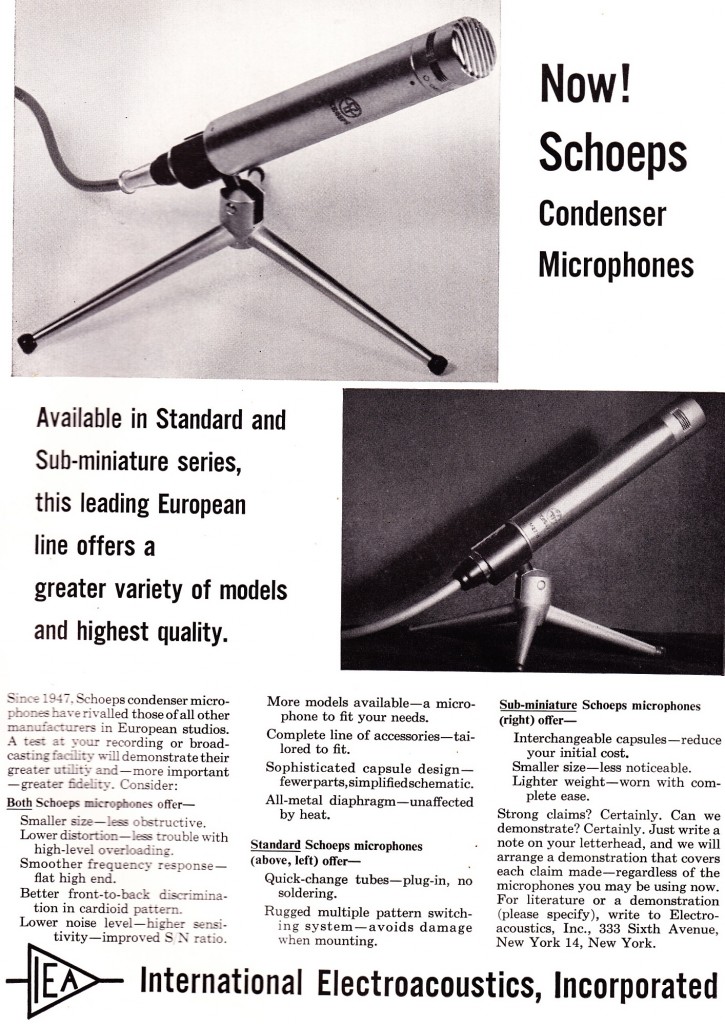 Above: Schoeps mics circa 1961. Schoeps have a deserved reputation as being the most high-fidelity of any widely-available microphones.
Above: Schoeps mics circa 1961. Schoeps have a deserved reputation as being the most high-fidelity of any widely-available microphones.
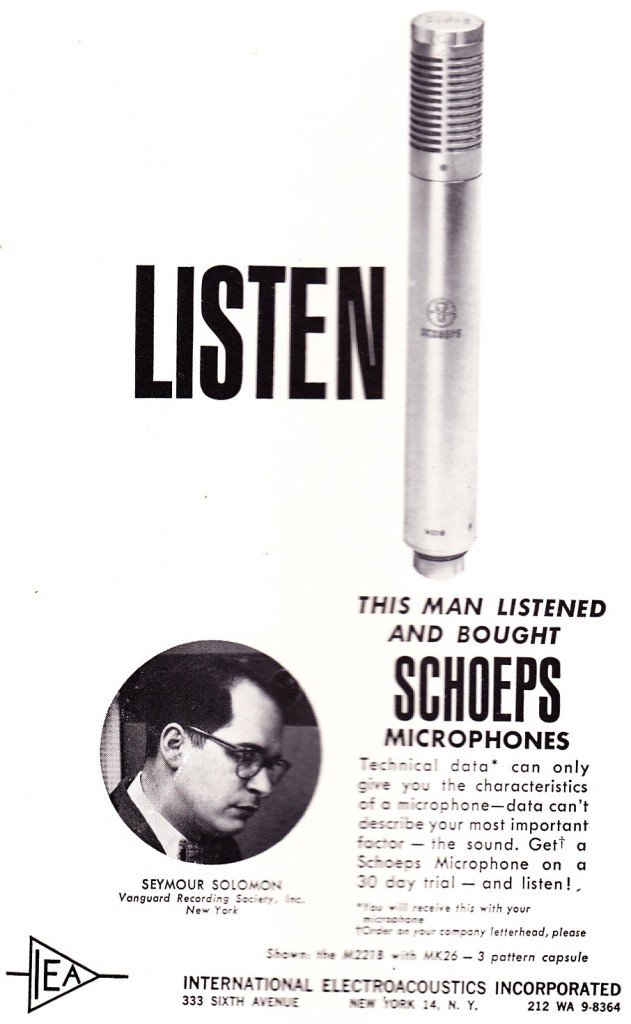 The Schoeps M221B microphone. I really, really need to get me a pair of Schoeps…
The Schoeps M221B microphone. I really, really need to get me a pair of Schoeps…
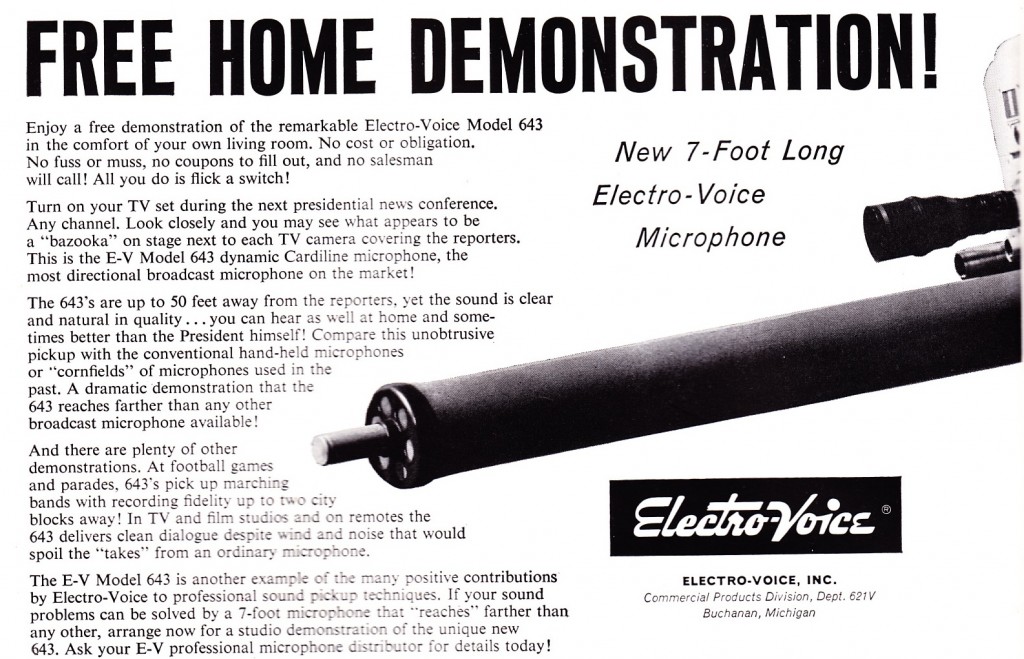
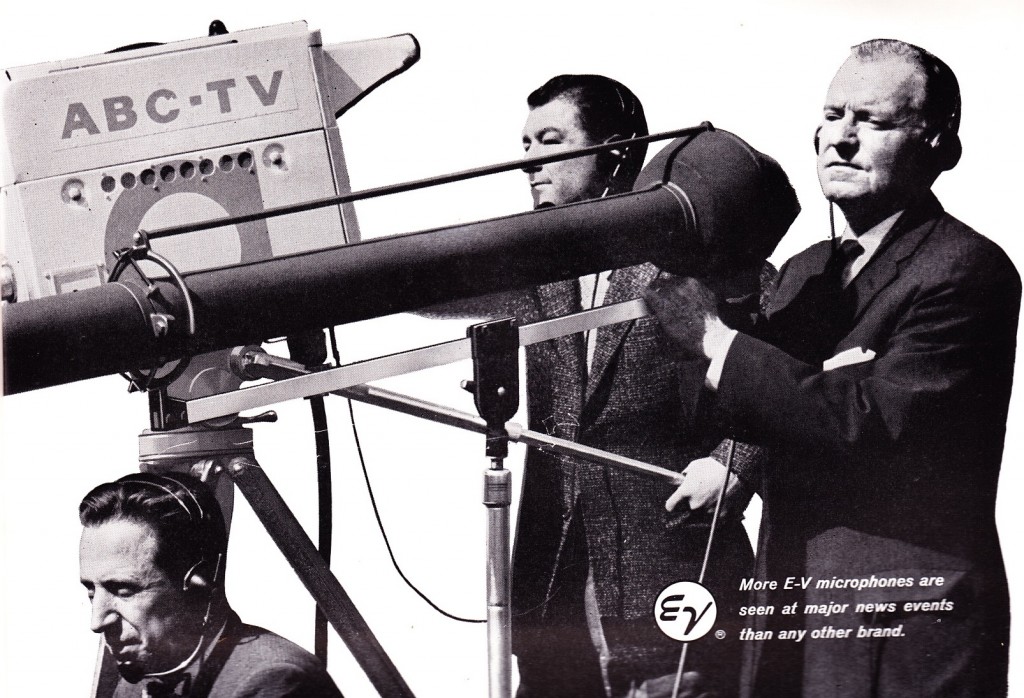 Above: the Electrovoice 643 super-directional microphone of 1961. The 643 was apparently developed by the same engineer who created the wonderful Electrovoice RE-20. Unlike the 643, the RE-20 is still in production, and still being used everyday around the world. As far as the 643…well… it was supposedly used in the 1960s for Presidential news conferences, but I can’t imagine seeing something like this aimed at a head-of-state today.
Above: the Electrovoice 643 super-directional microphone of 1961. The 643 was apparently developed by the same engineer who created the wonderful Electrovoice RE-20. Unlike the 643, the RE-20 is still in production, and still being used everyday around the world. As far as the 643…well… it was supposedly used in the 1960s for Presidential news conferences, but I can’t imagine seeing something like this aimed at a head-of-state today.
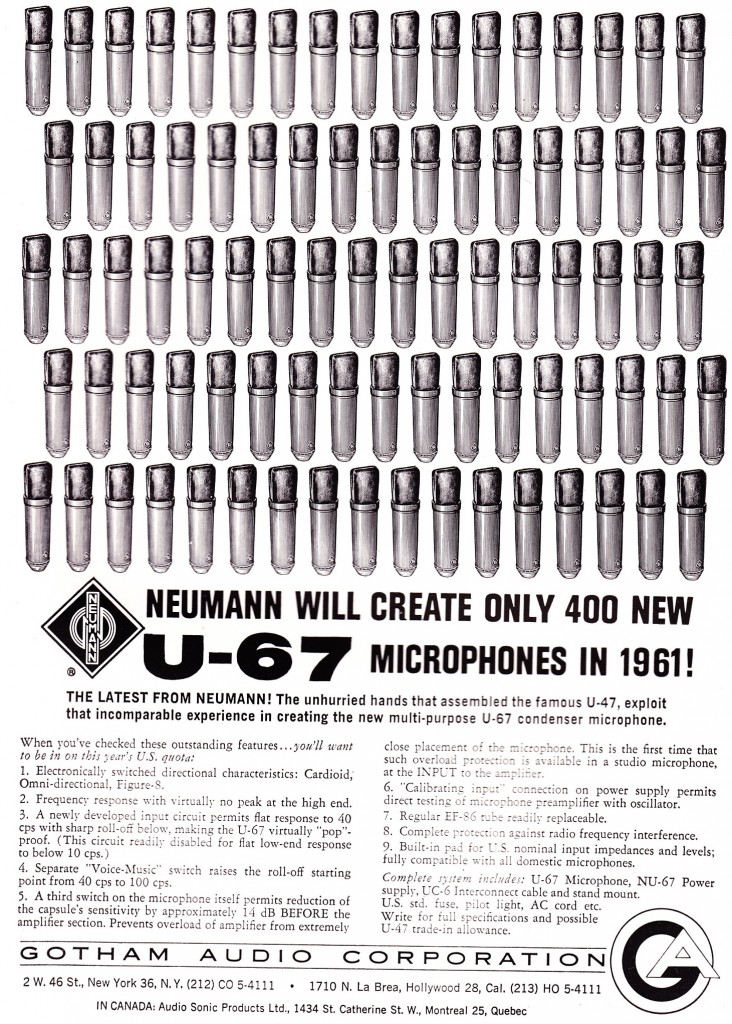 Above: the Neumann U-67 is announced. The U67 was the ‘bridge’ between the earlier U47 and the soon-to-be-ubiquitous U-87. Like the U-47 it is a tube mic. A U-67 just sold on eBay for $7k, which is not too surprising. It’s possible to turn up cheap U87s from time to time but the U67 had a much shorter run and not the same level of popularity.
Above: the Neumann U-67 is announced. The U67 was the ‘bridge’ between the earlier U47 and the soon-to-be-ubiquitous U-87. Like the U-47 it is a tube mic. A U-67 just sold on eBay for $7k, which is not too surprising. It’s possible to turn up cheap U87s from time to time but the U67 had a much shorter run and not the same level of popularity.
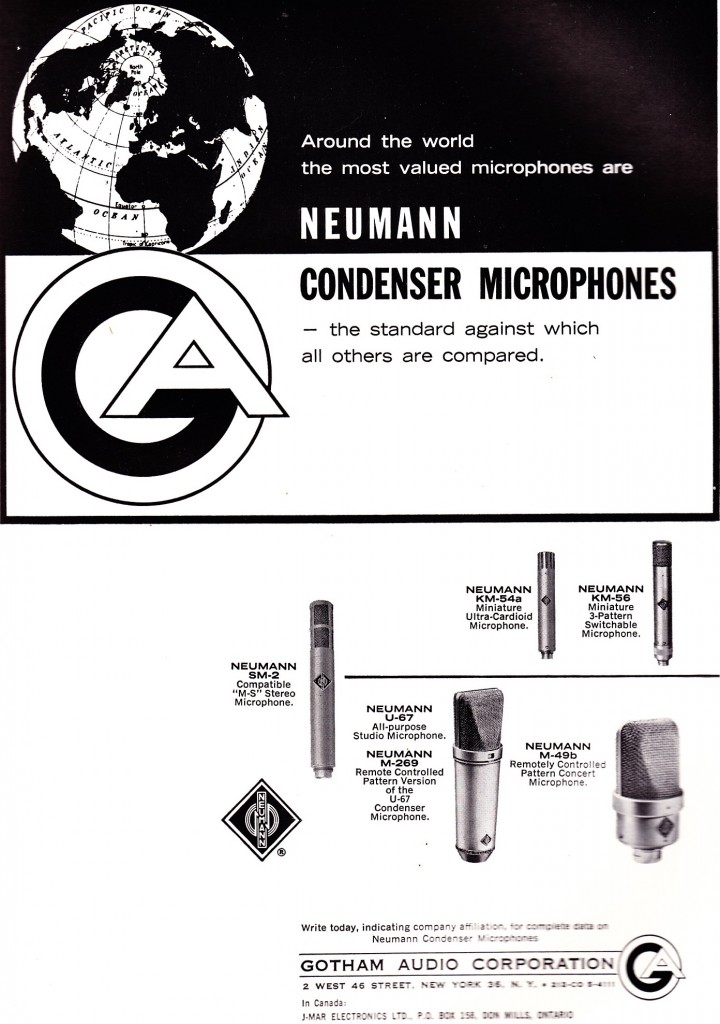 Above: the Neumann KM-54, KM-56, SM-2, U-67, M-49b, and M-269 microphones.
Above: the Neumann KM-54, KM-56, SM-2, U-67, M-49b, and M-269 microphones.
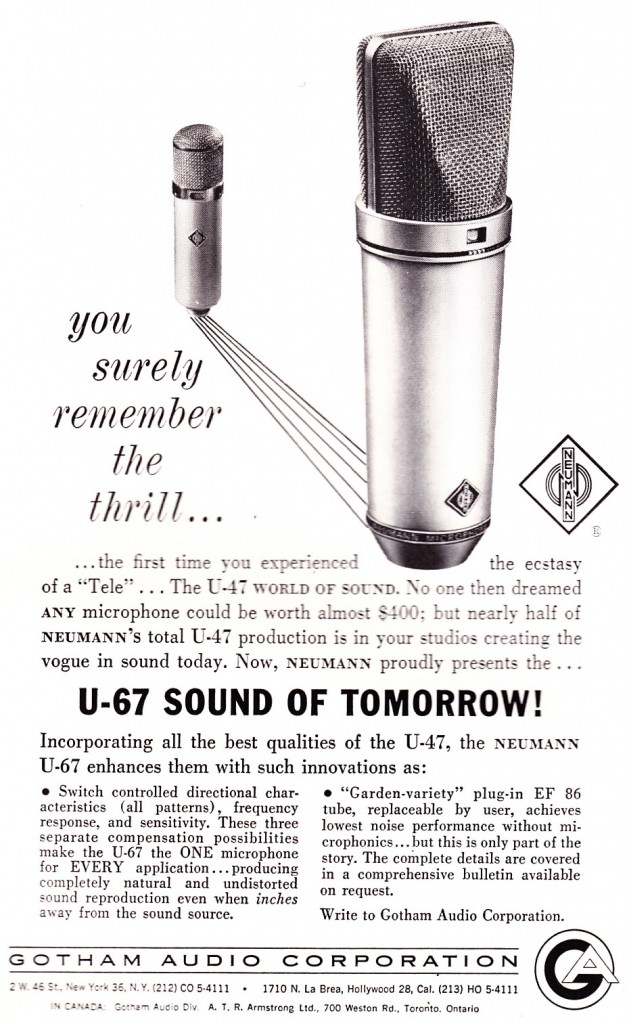 Another announcement ad for the U-67.
Another announcement ad for the U-67.
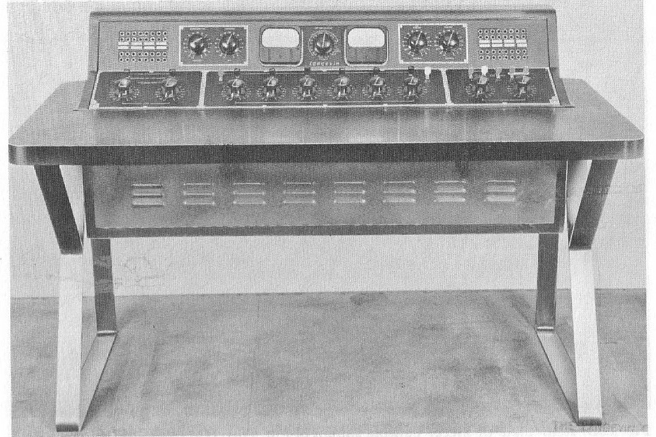 Langevin stereo console circa 1959
Langevin stereo console circa 1959
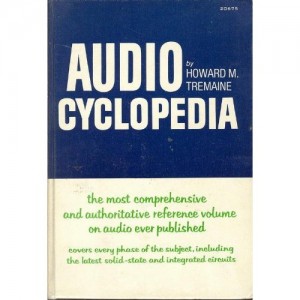 Today: from the “Audio Cyclopedia,” Howard Tremaine, 1959: a quick visual survey of professional mixing consoles in service in 1959. A PS Dot Com reader turned me on to the “Audio Cycolopedia”; many copies of this 1300ppp volume are available on Amazon and eBay starting at around $80; based on the number available, though, i feel like there’s a $1 yard-sale copy waiting for me just around the bend… When the moment presents itself, we’ll be sure to run an Out-Of-Print-Book Report.
Today: from the “Audio Cyclopedia,” Howard Tremaine, 1959: a quick visual survey of professional mixing consoles in service in 1959. A PS Dot Com reader turned me on to the “Audio Cycolopedia”; many copies of this 1300ppp volume are available on Amazon and eBay starting at around $80; based on the number available, though, i feel like there’s a $1 yard-sale copy waiting for me just around the bend… When the moment presents itself, we’ll be sure to run an Out-Of-Print-Book Report.
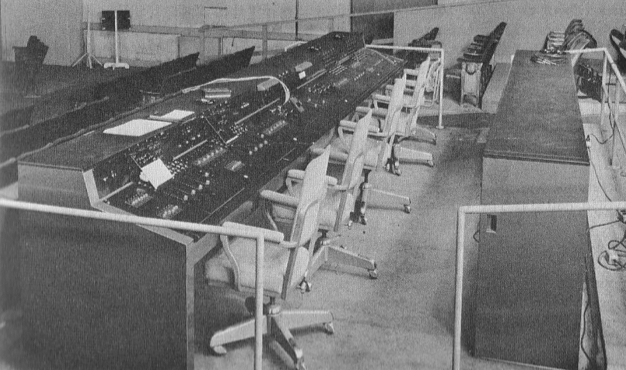 A Westrex console built for Todd-AO
A Westrex console built for Todd-AO
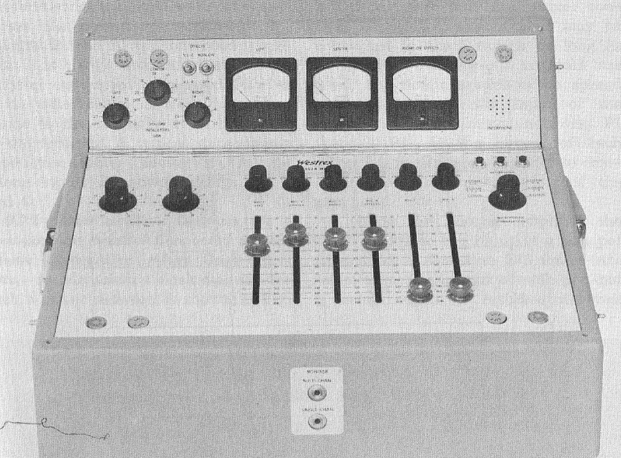
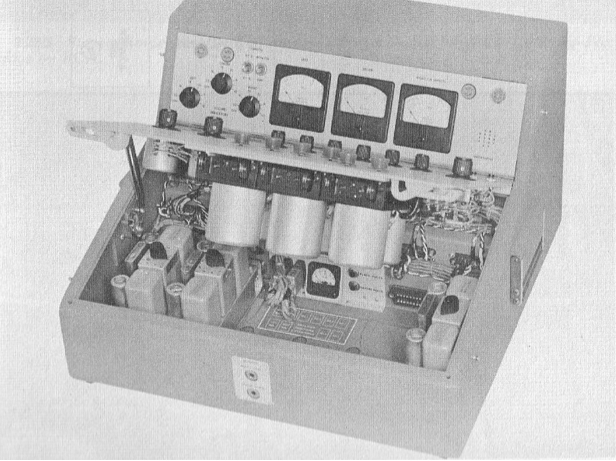 The Westrex Portable Stereo Mixer, inside+out
The Westrex Portable Stereo Mixer, inside+out
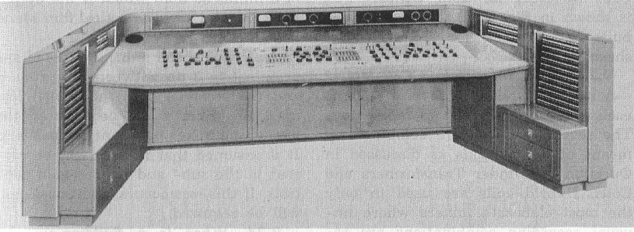 RCA Stereo Console built for 20th Century Fox
RCA Stereo Console built for 20th Century Fox
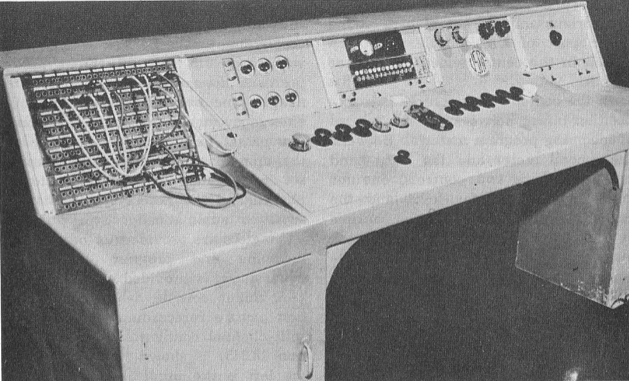 A ten-channel stereo console built for the production of USAF training films
A ten-channel stereo console built for the production of USAF training films
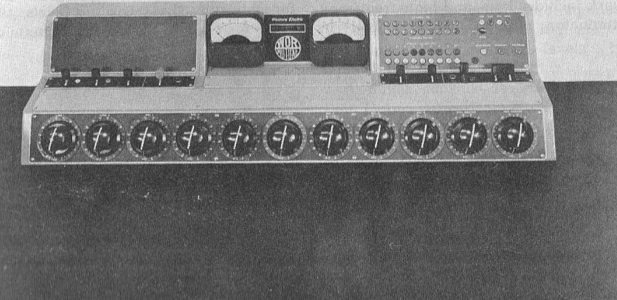 An eight-channel Western Electric console
An eight-channel Western Electric console
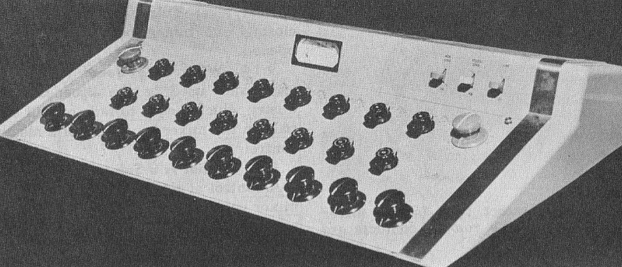 Cinema Engineering Console with integral channel equalization. These consoles were apparently introduced in 1951…
Cinema Engineering Console with integral channel equalization. These consoles were apparently introduced in 1951…
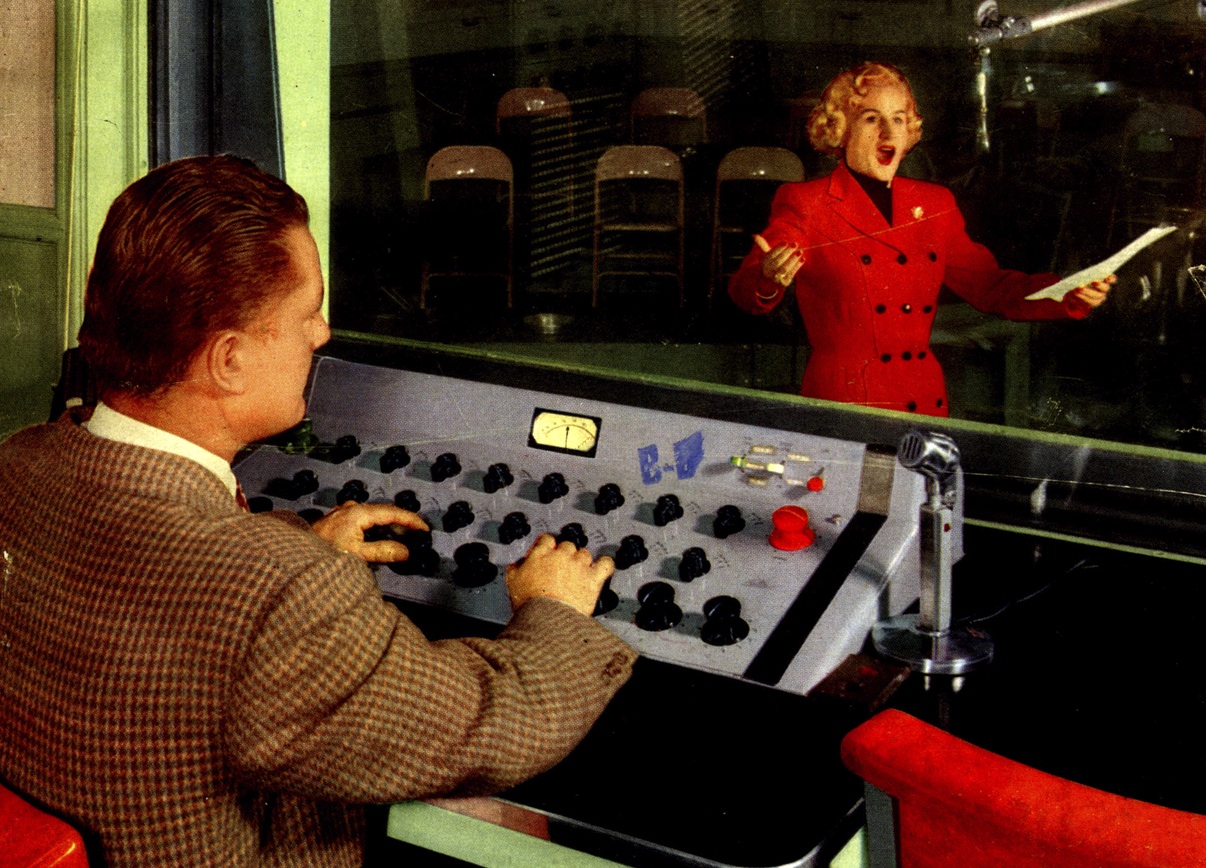 …as seen in this image from Radio & Television News, 1951. We’re looking at Capitol Records’ studio in this image.
…as seen in this image from Radio & Television News, 1951. We’re looking at Capitol Records’ studio in this image.
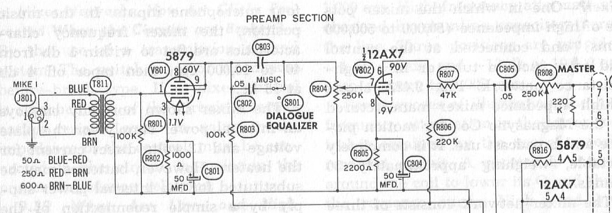 “Audio Cyclopedia” presents a range of material in an easy-to-read manner suitable for technical and non-technical persons alike; that being said, the book does not shy away from some very useful circuit data, such as the above-depicted Magnasync mixer schematic. I have been wondering for some time what the proper way was to use a 5879 tube in triode mode: here we see: 100k plate resistor with 1K bias resistor. Easy…
“Audio Cyclopedia” presents a range of material in an easy-to-read manner suitable for technical and non-technical persons alike; that being said, the book does not shy away from some very useful circuit data, such as the above-depicted Magnasync mixer schematic. I have been wondering for some time what the proper way was to use a 5879 tube in triode mode: here we see: 100k plate resistor with 1K bias resistor. Easy…
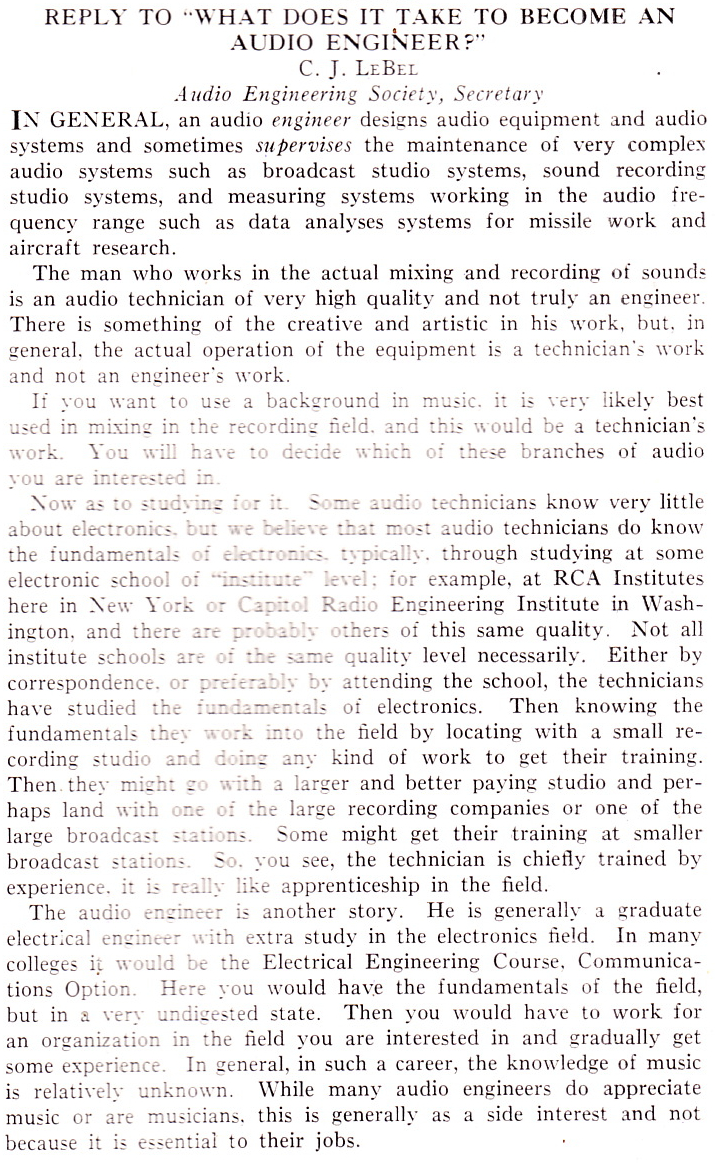 From an AES journal circa 1961. It’s interesting to see how the meaning of ‘audio engineer’ has shifted over the past half century. An ‘Audio Engineer’ circa 1961 would almost certainly be called a ‘tech’ or a ‘broadcast engineer’ today, while the circa ’61 ‘audio technician’ would almost certainly be called an engineer or mixer today.
From an AES journal circa 1961. It’s interesting to see how the meaning of ‘audio engineer’ has shifted over the past half century. An ‘Audio Engineer’ circa 1961 would almost certainly be called a ‘tech’ or a ‘broadcast engineer’ today, while the circa ’61 ‘audio technician’ would almost certainly be called an engineer or mixer today.
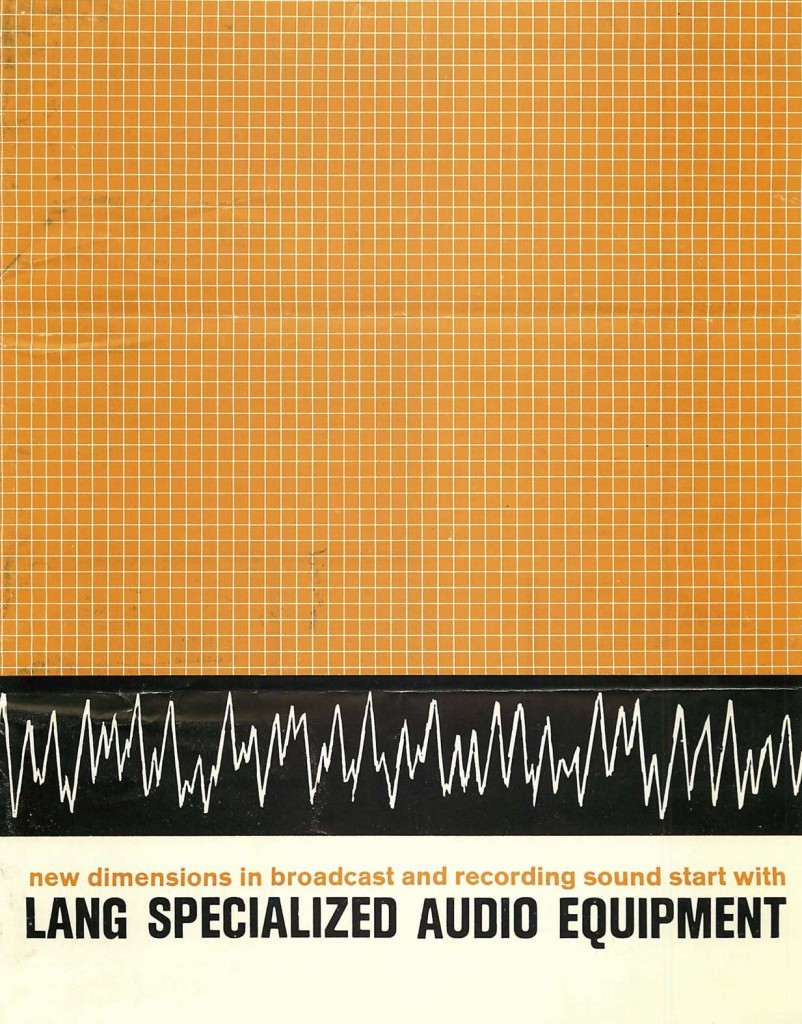 Download the six-page circa 1965 Lang Specialized Audio Equipment Catalog:
Download the six-page circa 1965 Lang Specialized Audio Equipment Catalog:
DOWNLOAD: Lang_Audio_Electronics_catalog
Products covered, with photos and text description, include: Lang LRP-1B tape recorder electronics (for Ampex 300 generation machines), LTP-1A tape playback amp, LRA-1C record/playback amp, LMX-4 and LMX-5 broadcast consoles, LMP-1 stereo portable mixer, Record Stereo Mixer, LMX-2 mixer, LPM-2 portable mixer, PEQ-2 and PEQ-3 equalizers, Lang Sync Panel, Disc Recording Equalizer, plus many more accessories.
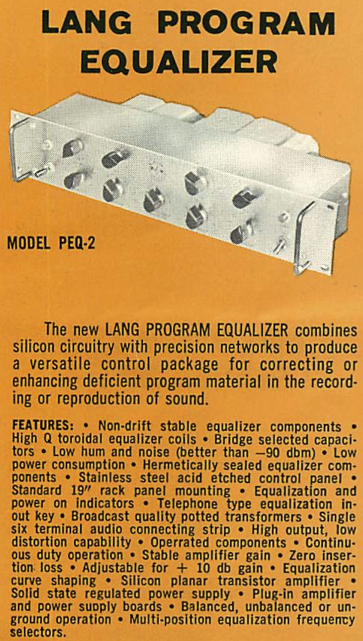
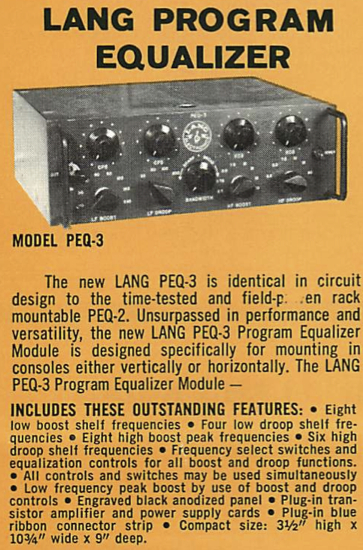 *******************************************
*******************************************
*******************************************
Lang was known primarily for the various upgrades and support equipment that they manufactured for Ampex tape machines. As shown above, they also offered solid-state equalizer that appear similar in function to the popular Pultec units of the era. There are also several models of audio mixers on offer, a few of which were available as early as 1961.
Above: the Lang ‘compact’ mono mixer. Advert circa 1961. Looks very similar to my later stereo Gately mixing system , which I spent $250 and several hours on…and i still can’t figure out what the hell i’m gonna use it for.
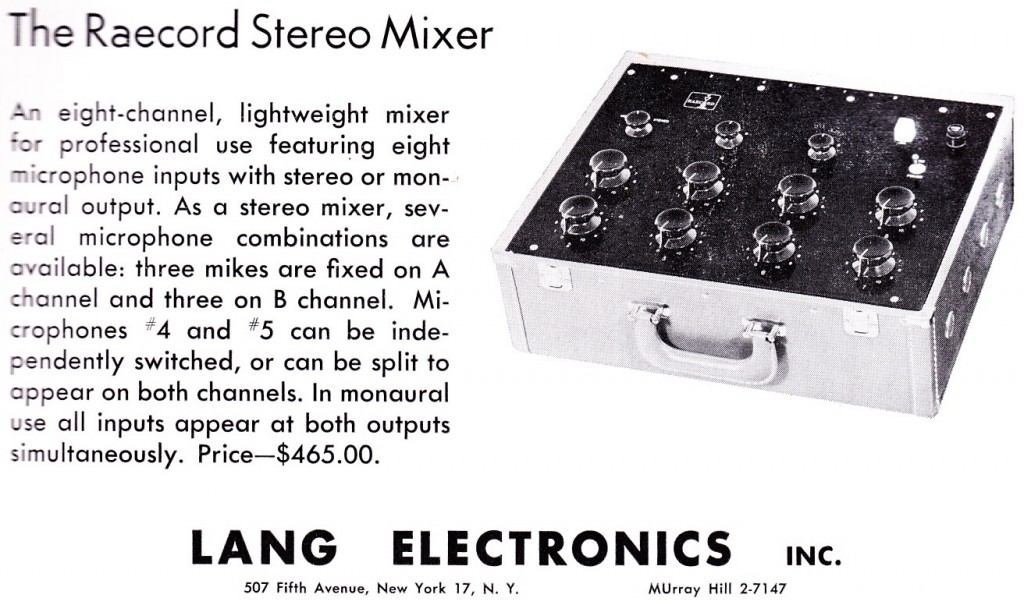 Above: the Lang Raecord portable stereo (of a sort…) mixer, also introduced circa 1961. Seems pretty scarce.
Above: the Lang Raecord portable stereo (of a sort…) mixer, also introduced circa 1961. Seems pretty scarce.
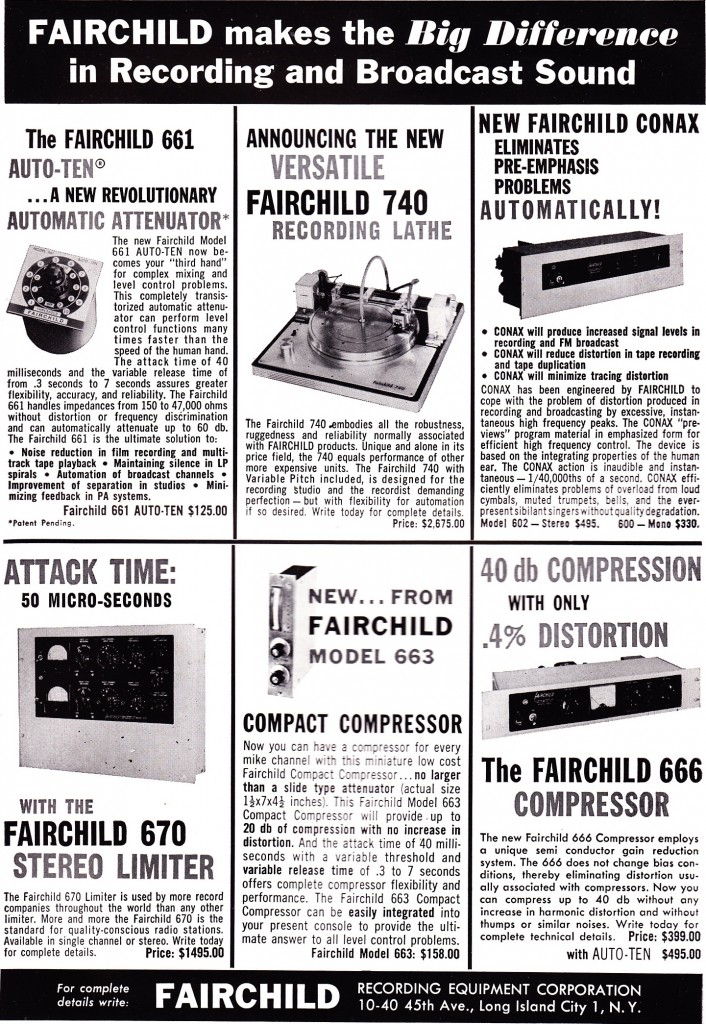 Above: the Fairchild 661 Auto-ten (a noise gate, apparently), 740 Lathe, 602 and 600 Conax (de-essers, apparently), 670 stereo limiter, 663 Compact console channel compressor, and 666 compressor, which wants you to know that it is emphatically NOT a vari-mu compressor.
Above: the Fairchild 661 Auto-ten (a noise gate, apparently), 740 Lathe, 602 and 600 Conax (de-essers, apparently), 670 stereo limiter, 663 Compact console channel compressor, and 666 compressor, which wants you to know that it is emphatically NOT a vari-mu compressor.
Today on PS dot com: some pro audio gear from NYC’s legendary Fairchild Recording Equipment Corporation. This post will strictly be a scan of marketing materials from the era, as I have never used or serviced any of these pieces (other than a 670 clone). A PS Dot Com reader alerted me to the fascinating story of Sherman Fairchild, the man behind the corporation that brought the world this very advanced audio technology: you will not be surprised to learn that he had roots in the aviation industry and a key connection to IBM. See the comments section or click here to learn more.
this gets a little lengthy so click below to READ ON…
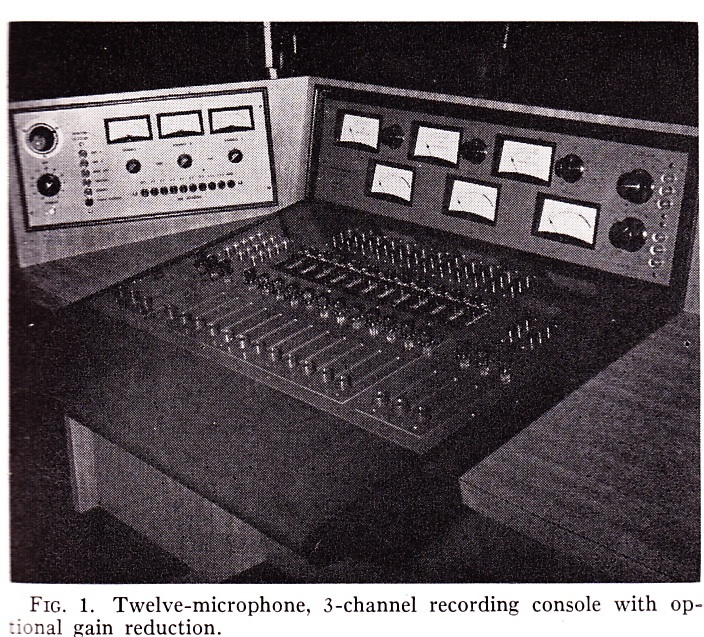 Above: 12×3 Audiofax mixing desk circa 1961.
Above: 12×3 Audiofax mixing desk circa 1961.
I was reading a 1961 AES journal when I came across this piece by Phillip Erhorn of Audiofax associates in which he details “New trends in stereo recording consoles.” Erhorn will let you have your channel EQs and compressors, but only very begrudgingly.
Here’s Erhorn describing how he feels the trend for extensive channel EQ developed:

 I mean, yeah, I agree, many condenser mics are hyped in the high end. But why the hostility, buddy? Oh and about all those channel compressors?
I mean, yeah, I agree, many condenser mics are hyped in the high end. But why the hostility, buddy? Oh and about all those channel compressors?
 Remember what I said a few posts back about The Pre Rock Era? How long did it take for our culture to shake off the idea that ‘verisimilitude to an actual acoustic event is the fundamental function of audio’? I’ll remind you that in only about 3 years’ time, EMI staff engineers would be pushing their modded’ Altec compressors hard to get the sounds that helped create the Beatles’ success. Oh the times they are a’changing.
Remember what I said a few posts back about The Pre Rock Era? How long did it take for our culture to shake off the idea that ‘verisimilitude to an actual acoustic event is the fundamental function of audio’? I’ll remind you that in only about 3 years’ time, EMI staff engineers would be pushing their modded’ Altec compressors hard to get the sounds that helped create the Beatles’ success. Oh the times they are a’changing.
Let’s get back to those swell-looking Audifax consoles tho…
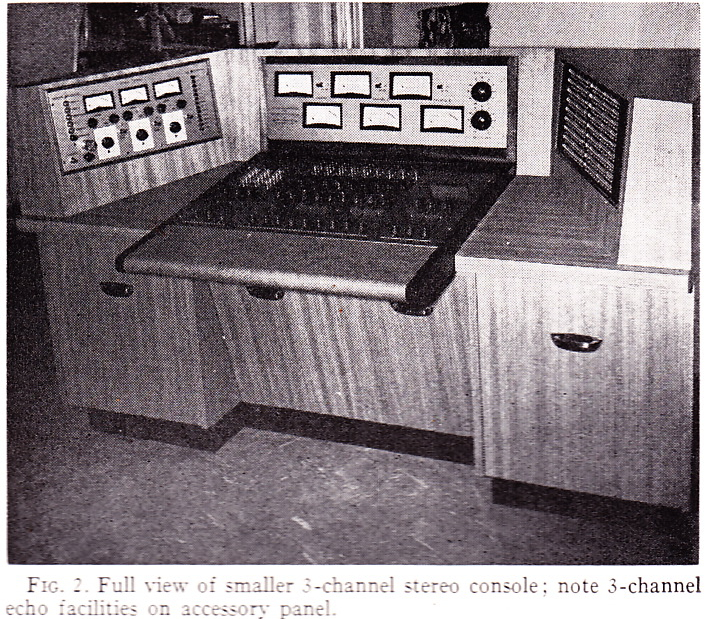
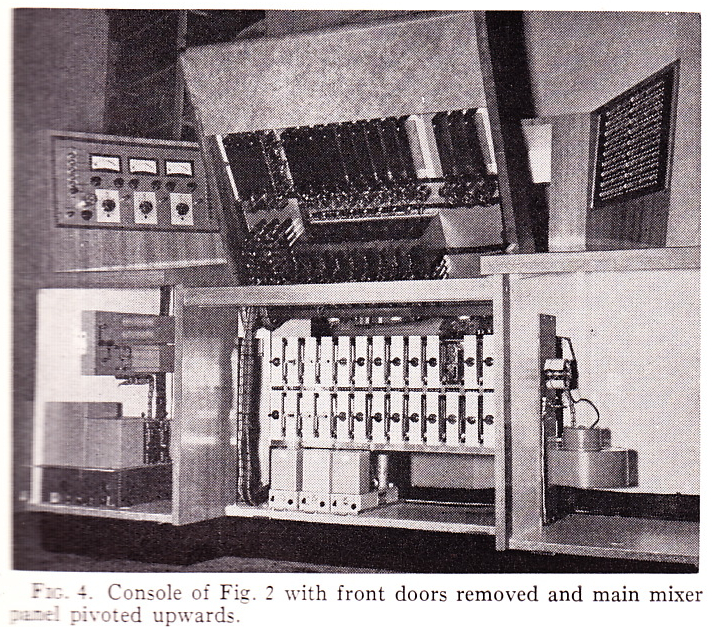 Above, the same 12×3 desk, inside and out. What a work of art this thing is! Someday. I . Will. Build. My. Own. Console.
Above, the same 12×3 desk, inside and out. What a work of art this thing is! Someday. I . Will. Build. My. Own. Console.
************
*******
***
I am going to take a bit of a left turn here. Not exactly like Jung’s Left Hand Path but… Let’s get back to the hostility towards this new idea of audio-as-sound-modification-technology (as opposed to documentation-technology) that we read in the passages above. Erhorn was/is obvs a very talented man who cared deeply about music or he would not have gained the skills/drive to construct the intricate pieces we see above. So his views can’t just be written off. Which begs the question: If Erhorn’s views as an accomplished audio professional were, in 1961, slated for imminent obsolescence, then which of our current paradigms are headed for the dustbin? I don’t think the answer has anything to do with fidelity or even any particular kind of recording technology, necessarily. In 1961, the history of audio trends was simply an upward vector. Higher fidelity was ‘better.’ Frequency response and distortion % was always getting ‘better.’ Progress towards increased fidelity was the paradigm, and any deviation from this progress (such as the need to ‘EQ’ a mic to achieve a supposed marketing prerogative or the need to compress a loud, ‘music-less’ but sale-able band of youths) was bad, right?
Well, the ‘fidelity problem’ was pretty much solved by the late 1970s… the high-end of professional and consumer equipment available at that time is as close-to-perfect, in terms of sheer audio performance, as any user is likely to need. Which is why the manufacturers turned towards the convenience problem instead. This brought us the Walkman, the CD, and ultimately, the MP3. So with the ‘fidelity problem’ solved, and all of our attention now collectively focused on the ‘convenience problem,’ we abandonded the paradigm of the upward vector of fidelity and instead enter an age of fidelity-trends. High-fidelity sounds are in vogue for a while; and them low-fi and distorted sounds become popular. We then tire of the low-fi and artists start making slick-sounding records again. Etc., etc. Now, there are real moments in the culture that precipitate each of these shifts, but the pattern seems likely to keep repeating. The point is: neither hi-fi nor low-fi are going anywhere. We now have a plurality of acceptable approaches to the generation of recorded musical performances. So what’s to obselecse then? Which viewpoint is about to become hopelessly outdated?
It’s my current feeling that the answer has something to do with copyright, ownership, and fair use. Not fidelity, not any particular recording technology, but copyright and the idea of what kind of ‘use’ of existing recorded materials constitutes a valid new work. I really get the sense from younger artists, as well as my students, that existing recordings — audio-masters made and paid for by other people — are fair game for use in their own productions: no credit or compensation necessary. Of course ‘sampling’ occurred in hip hop for ten years before rap artists had to start paying fees to use recognizable samples in their tracks, but I am more talking about the newer trend of simply lifting an obscure existing song, performing some tweaks on it, and calling it your own production. And maybe it is! Who is to say, really. And that’s kind of the point I am trying to make. If you are a young contemporary musician, what is the material that you work with? What are the compositional elements that you are concerned with? It is the notes E2 – E6 on an electric guitar? Or is anything and everything that you can download for free from the internet? If you want some concrete examples of the kind of music that I am talking about, check out this thread on Hipster Runoff. If you are unfamiliar with HRO, the tone might take a little getting used-to, but the musical examples that the author presents are very valid. Listen to the tracks. Be aware that these are some of the most popular, most relevant rock-music acts in the world today. And ask yrself: how do you feel about this? Can you accept the paradigm shift that is emerging? Can you appreciate that this paradigm shift is taking place at the precise moment that the economic base of the century-old Recording Industry is almost fully collapsed? And while you are pondering that, recall the Marxist relation between base and superstructure, this idea that economic conditions necessarily construct cultural conditions?
Here’s those free music-production apps you asked for. Now go… make some music.
Good lord take a look at this thing. The Phillips EL 6911 echo machine. Distributed in the US by Norelco, who also distro’d AKG mics in the 1960s. You can find much more information on this monster at this website. These still turn up on eBay from time to time.
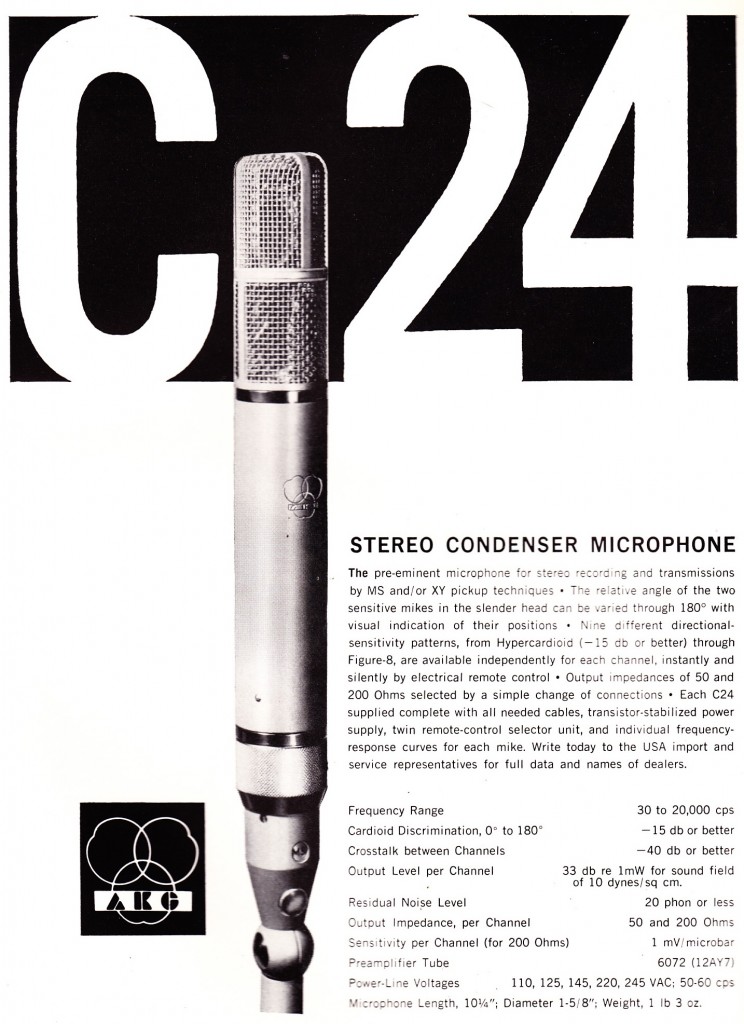 The AKG C-24 stereo condenser mic. Yes please. I think if I added up all the time i have spent mounting my Neumann TLM 103s on their X/Y mount I would i run out and buy one of these. Oh wait! I don’t have $12,000! Nevermind! Anyone have a strong reco for an affordable XY mic that will put the TLM 103s back in their cases for good?
The AKG C-24 stereo condenser mic. Yes please. I think if I added up all the time i have spent mounting my Neumann TLM 103s on their X/Y mount I would i run out and buy one of these. Oh wait! I don’t have $12,000! Nevermind! Anyone have a strong reco for an affordable XY mic that will put the TLM 103s back in their cases for good?
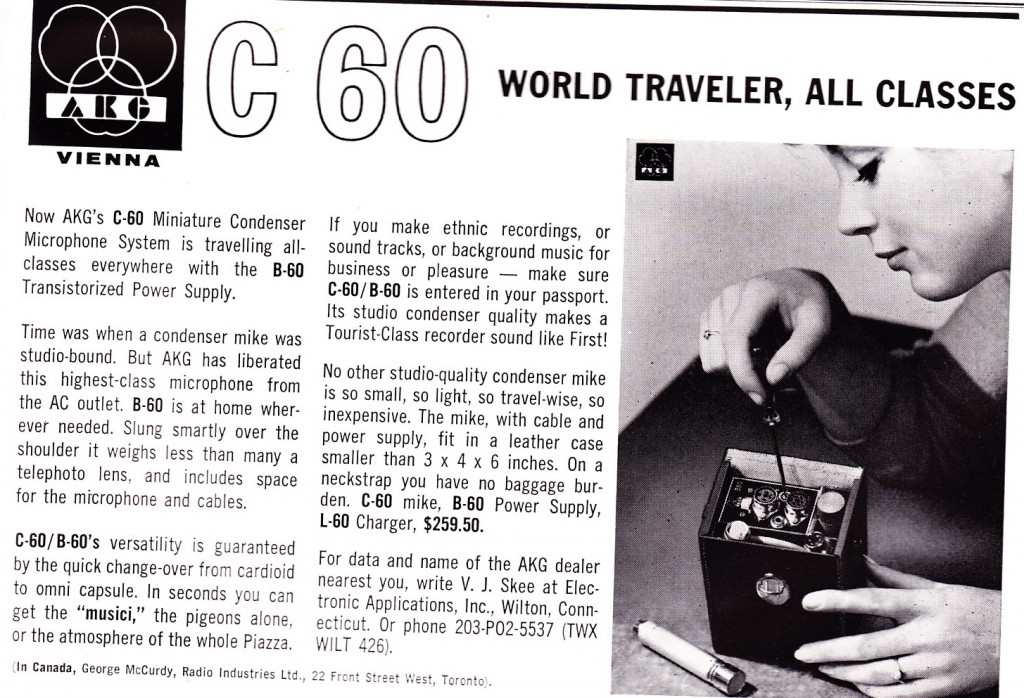
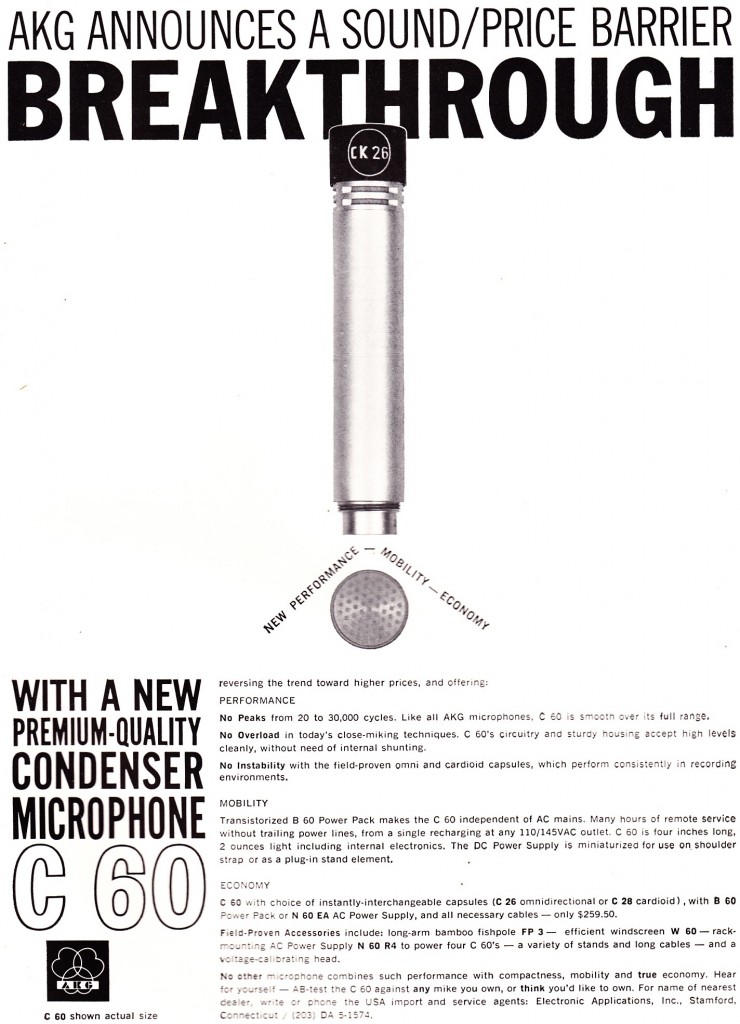 Above, and above: the AKG C 60. I’ve never used one of these. Nice-looking example on eBay right now for $850.
Above, and above: the AKG C 60. I’ve never used one of these. Nice-looking example on eBay right now for $850.
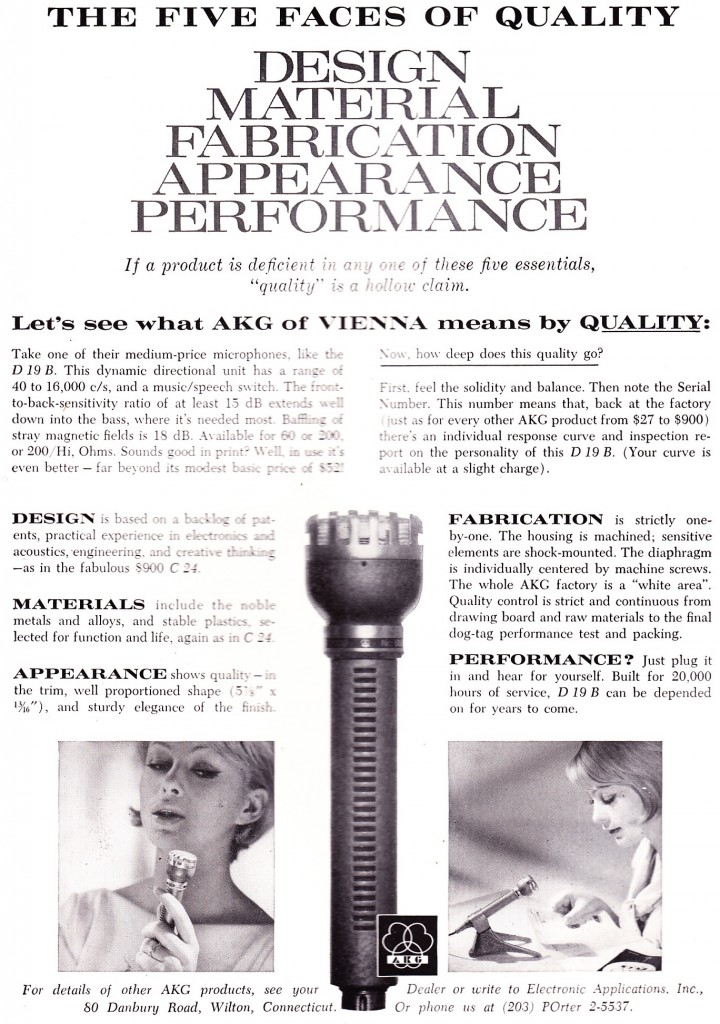 The AKG D19. I own one of these, and I have used it on a few tracks…nice for low-fi-ish hard-strumming steel-string acoustic gtr. Based on my experience, I feel like the stated claim of 40-16k hz response is extremely optimistic. The D19 shows up in a few places in music history: most notably as one of the go-to mics at Abbey Road during the Beatles early sessions. It also shows up in this Elvis/Martina McBride video (see here) wherein Martina duets with The King. I was working at SONYMUSIC when this video was produced, and I couldn’t help but wonder… in the original ’68 Comeback special, Elvis is using an EV RE15... which looks an awful lot like a D19… Martina’s husband/engineer John McBride is one the biggest Beatles fans in the world… antique microphone conspiracy theories, take one.
The AKG D19. I own one of these, and I have used it on a few tracks…nice for low-fi-ish hard-strumming steel-string acoustic gtr. Based on my experience, I feel like the stated claim of 40-16k hz response is extremely optimistic. The D19 shows up in a few places in music history: most notably as one of the go-to mics at Abbey Road during the Beatles early sessions. It also shows up in this Elvis/Martina McBride video (see here) wherein Martina duets with The King. I was working at SONYMUSIC when this video was produced, and I couldn’t help but wonder… in the original ’68 Comeback special, Elvis is using an EV RE15... which looks an awful lot like a D19… Martina’s husband/engineer John McBride is one the biggest Beatles fans in the world… antique microphone conspiracy theories, take one.
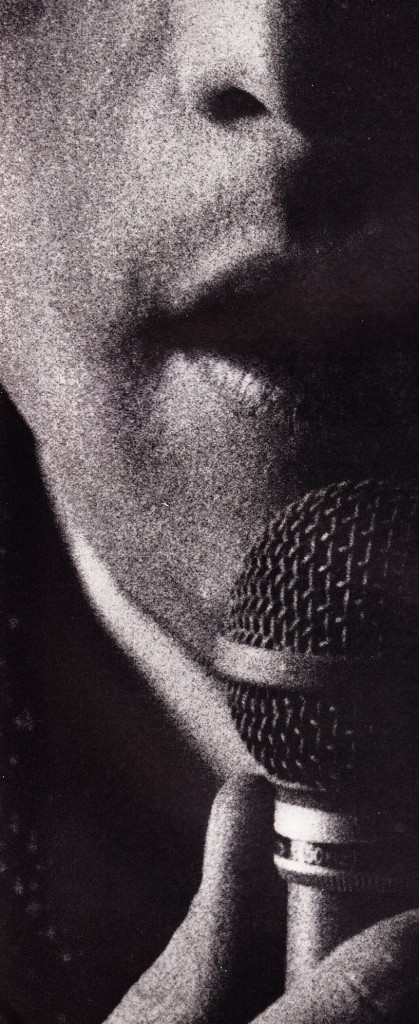
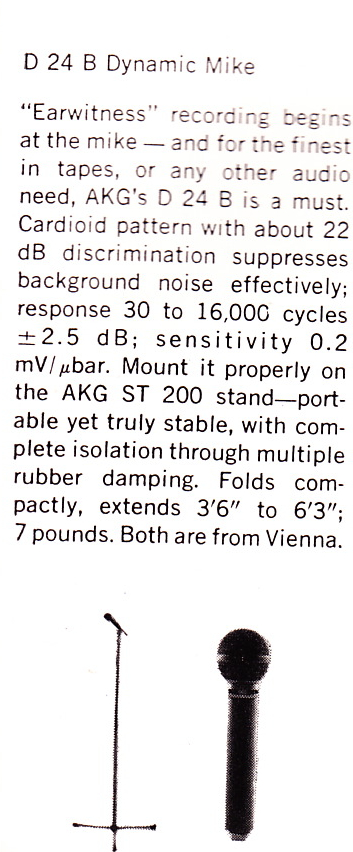 ***************************************** *****************************************
***************************************** *****************************************
The AKG D24 Dynamic mic. Anyone?
Previous vintage AKG microphone coverage on Preservation Sound: